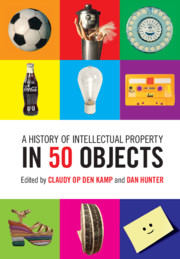Book contents
- Frontmatter
- Dedication
- Contents
- Acknowledgments
- Introduction: Of People, Places, and Parlance
- The Pre-Modern Period
- The Age of invention
- Modern Times
- The Consumption Age
- The Digital Now
- 39 Polymer Banknote
- 40 Post-it Note
- 41 Betamax
- 42 Escalator
- 43 3D Printer
- 44 CD
- 45 Internet
- 46 Wi-Fi Router
- 47 Viagra Pill
- 48 Qantas Skybed
- 49 Mike Tyson Tattoo
- 50 Bitcoin
- About The Contributors
48 - Qantas Skybed
from The Digital Now
Published online by Cambridge University Press: 12 June 2019
- Frontmatter
- Dedication
- Contents
- Acknowledgments
- Introduction: Of People, Places, and Parlance
- The Pre-Modern Period
- The Age of invention
- Modern Times
- The Consumption Age
- The Digital Now
- 39 Polymer Banknote
- 40 Post-it Note
- 41 Betamax
- 42 Escalator
- 43 3D Printer
- 44 CD
- 45 Internet
- 46 Wi-Fi Router
- 47 Viagra Pill
- 48 Qantas Skybed
- 49 Mike Tyson Tattoo
- 50 Bitcoin
- About The Contributors
Summary
A LOT OF thought goes into what we sit on. From the design of the office chair to the cafe bench, kitchen stool, or couch where we watch television. For consumers, even more thought goes into what we sit on when we fly. Either domestic or international, we all have ourpreferences. Starting with which airline, then the location within the aeroplane—either up front or behind the wing. Finally, our preference for aisle or window, but never choosing a middle seat. Choice matters and can influence passengers to pay more than an economy fare. Design also plays a part and can affect a consumer's experience when flying. Good design can also play a role in linking innovation and the commercial success of products and services. Airplane seating is no exception.
Less thought goes into understanding the importance of design. Qantas Airlines Australia, however, recognized the importance of design and equally its protection and with the inception of the Skybed, it changed the perception of international business-class travel and what it means to fly. Design played a key role and created a consumer experience that was more functionally efficient and more aesthetically pleasing. The Qantas Skybed is an illustrative example of the unseen connections between industry, designer, consumer experience and design law.
In 2001, Qantas approached Marc Newson, a designer famous for his Lockheed Lounge and Embryo chair, to create a new business-class seat. The seat would need to recline and produce a flat bed. Qantas knew what drove customers to choose business class: comfort, privacy, and flexibility. The Newson seat would achieve all this, but also create a new sense of space for passengers either while working, relaxing, sleeping, or being entertained. Newson designed a retro-futuristic business-class seat with a sculpted carbon fibre back shell. Although not the first flatbed business-class seat—British Airways introduced the first in 1999—the Skybed was the longest at two meters fully reclined. The innovative design went on to win the Good Design Award from the Chicago Athenaeum Museum in 2003 and, a year later, an Australian Design Award. Following the successful launch and acclaim of the Skybed, Qantas asked Marc Newson back to redesign the entire cabin interior of Qantas’ new A380 fleet. To Qantas, the Skybed was the crown jewel of a $385 million modernization process.
- Type
- Chapter
- Information
- A History of Intellectual Property in 50 Objects , pp. 392 - 399Publisher: Cambridge University PressPrint publication year: 2019

